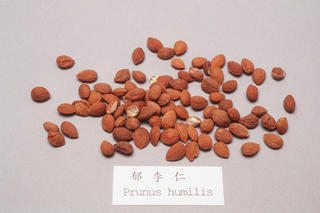Difference between revisions of "Prunus humilis"
(Created page with "right == Nomenclature== === Other Names:=== == Historical Use of Prunus humilis== === Prunus humilis in Traditional Chinese Medicine=== ==Background== '''C...") |
(No difference)
|
Latest revision as of 14:31, 21 March 2013
Contents
Nomenclature
Other Names:
Historical Use of Prunus humilis
Prunus humilis in Traditional Chinese Medicine
Background
Chinese Name (pinyin): Yuliren
Chinese Name :
Common Name :Bush Cherry Seed
Specific Name : Semen pruni
Scientific Name:
Collection : The fruit is collected in summer and autumn, removed from sarcocarp and the shells. The seed is collected and dried.
Description : Xiaoliren: Ovoid, 5 - 8mm long, 3 - 5mm in diameter. Externally yellowish white or pale brown, one end acute and the other end obtuse with linear hilum on the edge of the cute end and dark colored chalaza at the center of the obtuse end from which many vascular bundle extend upwards. Testa thin, cotyledons 2, milky white, oily, slight odor and taste slightly bitter.Dalliren: 6 - 10mm long, 5 - 7 mm in diameter, externally yellowish brown.
Identification : To 0.5g of the powder in a stopper test tube, add 3ml of 5% solution of sulfuric acid, mix well, hang a strip of trinitrophenol TP in the test tube, keep the TP a distance from the solution and stopper tightly. Heat on a water bath at 40 - 50ºC for 10 minutes, the test paper turns to red color.
Processing : Eliminate foreign matter, break to pieces before use.
Action : To relax th ebowels, and to cause diuresis.
Indication : stagnancy of undigested food with abdominal distension and constipation; weakness and edema of the legs with oliguria
Precautions : Used with caution in pregnancy.
Dosage : 6 to 9 g.
Storage : Preserve in a cool and dry place, protected from moth.
Nomenclature
Other Names:
Historical Use of Prunus humilis
Prunus humilis in Traditional Chinese Medicine
Background
Chinese Name (pinyin): Yuliren
Chinese Name :
Common Name :Bush Cherry Seed
Specific Name : Semen pruni
Scientific Name:
Collection : The fruit is collected in summer and autumn, removed from sarcocarp and the shells. The seed is collected and dried.
Description : Xiaoliren: Ovoid, 5 - 8mm long, 3 - 5mm in diameter. Externally yellowish white or pale brown, one end acute and the other end obtuse with linear hilum on the edge of the cute end and dark colored chalaza at the center of the obtuse end from which many vascular bundle extend upwards. Testa thin, cotyledons 2, milky white, oily, slight odor and taste slightly bitter.Dalliren: 6 - 10mm long, 5 - 7 mm in diameter, externally yellowish brown.
Identification : To 0.5g of the powder in a stopper test tube, add 3ml of 5% solution of sulfuric acid, mix well, hang a strip of trinitrophenol TP in the test tube, keep the TP a distance from the solution and stopper tightly. Heat on a water bath at 40 - 50ºC for 10 minutes, the test paper turns to red color.
Processing : Eliminate foreign matter, break to pieces before use.
Action : To relax th ebowels, and to cause diuresis.
Indication : stagnancy of undigested food with abdominal distension and constipation; weakness and edema of the legs with oliguria
Precautions : Used with caution in pregnancy.
Dosage : 6 to 9 g.
Storage : Preserve in a cool and dry place, protected from moth.
Synonymns for Prunus humilis
Patent Medicines and Medicines with Multiple Ingredients that include Prunus humilis
Pharmaceutical Information
Chemical Constituents
Evidence or the Use of Prunus humilis in the Treatment of Epilepesy
Basic Science
Animal Studies
Cohort, Case-Control and Non-Randomized Trials
Randomized Controlled Trials
Meta-Analysis
1st Five Results: pubmed search
Ping Li, Zihan Zhao, Zongshuo Li, Rong Zeng, Weidong Li
Distinguishing features of Prunus humilis, P. japonica, P. pedunculata seeds and their adulterant based on DNA barcoding, morphological characterization, and chemical profiles.
Fitoterapia: 2024, 175;105942
[PubMed:38575088]
[WorldCat.org]
[DOI]
(I a)
Rui Yang, Yan Yang, Yang Hu, Lu Yin, Pengyan Qu, Pengfei Wang, Xiaopeng Mu, Shuai Zhang, Peng Xie, Chunzhen Cheng, Jiancheng Zhang
##Title##
Molecules: 2023, 28(17);
[PubMed:37687101]
[WorldCat.org]
[DOI]
(I e)
Ping Li, Jiaji Chen, Chang-E Guo, Weidong Li, Zhiliang Gao
##Title##
Food Funct: 2023, 14(18);8248-8260
[PubMed:37655677]
[WorldCat.org]
[DOI]
(I e)
Correction to: The genome of Prunus humilis provides new insights to drought adaption and population diversity.
DNA Res: 2022, 29(6);
[PubMed:36562116]
[WorldCat.org]
[DOI]
(I p)
Xiao Long Ji, Mingyu Zhang, Di Wang, Zhe Li, Shaoyu Lang, Xing Shun Song
Genome-wide identification of WD40 superfamily in Cerasus humilis and functional characteristics of ChTTG1.
Int J Biol Macromol: 2023, 225;376-388
[PubMed:36402390]
[WorldCat.org]
[DOI]
(I p)
